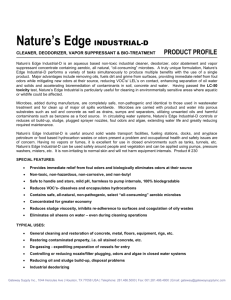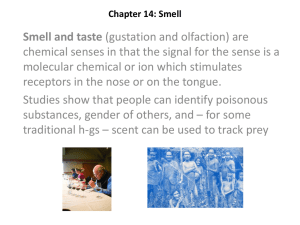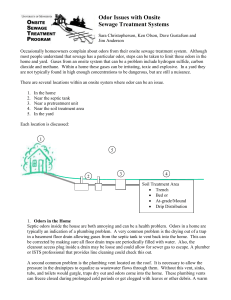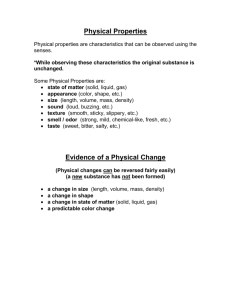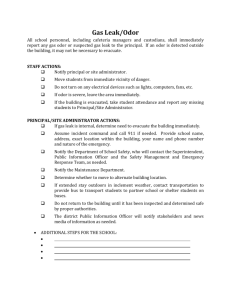File
advertisement
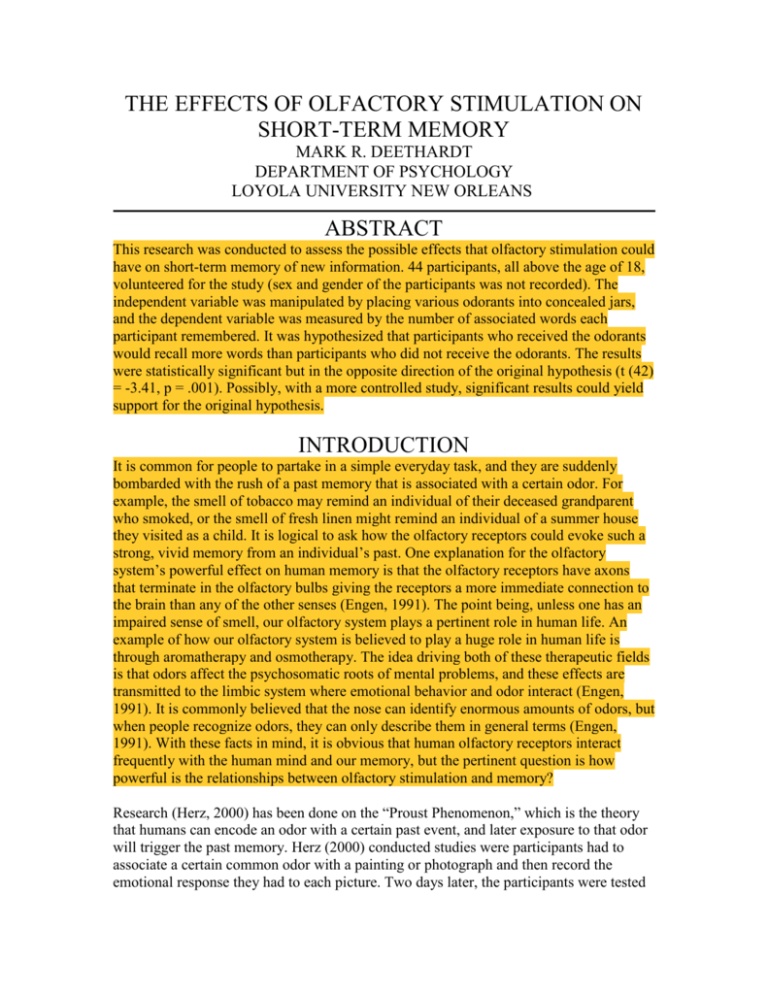
THE EFFECTS OF OLFACTORY STIMULATION ON SHORT-TERM MEMORY MARK R. DEETHARDT DEPARTMENT OF PSYCHOLOGY LOYOLA UNIVERSITY NEW ORLEANS ABSTRACT This research was conducted to assess the possible effects that olfactory stimulation could have on short-term memory of new information. 44 participants, all above the age of 18, volunteered for the study (sex and gender of the participants was not recorded). The independent variable was manipulated by placing various odorants into concealed jars, and the dependent variable was measured by the number of associated words each participant remembered. It was hypothesized that participants who received the odorants would recall more words than participants who did not receive the odorants. The results were statistically significant but in the opposite direction of the original hypothesis (t (42) = -3.41, p = .001). Possibly, with a more controlled study, significant results could yield support for the original hypothesis. INTRODUCTION It is common for people to partake in a simple everyday task, and they are suddenly bombarded with the rush of a past memory that is associated with a certain odor. For example, the smell of tobacco may remind an individual of their deceased grandparent who smoked, or the smell of fresh linen might remind an individual of a summer house they visited as a child. It is logical to ask how the olfactory receptors could evoke such a strong, vivid memory from an individual’s past. One explanation for the olfactory system’s powerful effect on human memory is that the olfactory receptors have axons that terminate in the olfactory bulbs giving the receptors a more immediate connection to the brain than any of the other senses (Engen, 1991). The point being, unless one has an impaired sense of smell, our olfactory system plays a pertinent role in human life. An example of how our olfactory system is believed to play a huge role in human life is through aromatherapy and osmotherapy. The idea driving both of these therapeutic fields is that odors affect the psychosomatic roots of mental problems, and these effects are transmitted to the limbic system where emotional behavior and odor interact (Engen, 1991). It is commonly believed that the nose can identify enormous amounts of odors, but when people recognize odors, they can only describe them in general terms (Engen, 1991). With these facts in mind, it is obvious that human olfactory receptors interact frequently with the human mind and our memory, but the pertinent question is how powerful is the relationships between olfactory stimulation and memory? Research (Herz, 2000) has been done on the “Proust Phenomenon,” which is the theory that humans can encode an odor with a certain past event, and later exposure to that odor will trigger the past memory. Herz (2000) conducted studies were participants had to associate a certain common odor with a painting or photograph and then record the emotional response they had to each picture. Two days later, the participants were tested to see if they could smell the same odors and then recall details about the pictures that were associated with them (Herz, 2000). In this experiment, Herz (2000) found that equal number of pictures were correctly recalled with olfactory, visual, tactile, and auditory cues. The results of this research showed that odors are just as strong as visual, tactile, and auditory sensory cues in eliciting the details of a past event, but not any more so than these other sensory cues (Herz, 2000). The only difference found in this research was that more emotions were associated with recalled memories triggered by odors, but the amount of detail recalled about the odor memory was no greater than memories triggered by visual, tactile, and auditory sensory associations (Herz, 2000). This research shows that indeed olfactory stimulation does play a role in recalling events stored in the subjects long-term memory, but recollection of memories through olfactory stimulation cannot be labeled as the best cue to memory (Herz, 2000). Other relevant research was done in the 70’s (i.e., Engen, Kuisma, & Eimas, 1973; Engen & Ross, 1973) on short-term memory of odors and on long-term memory of odors with and without verbal descriptions. In the first study on short-term memory for odors, participants were tested to see if the duration of the time interval in which they were presented with an odor had any effect on their memory of the odor (Engen, et al., 1973). In this research, participants were presented with 100 odorants in four groups of 25. The odors were presented at three second intervals, and the researcher would randomly make the participant count backwards from a random number in intervals of three. The researchers would then wait either 6, 12, or 30 seconds and would randomly introduce one of the 100 odorants to the participant, and then the participant was asked whether the odor was new or old. The results of this study were seen as unusual because it showed that the ability to recall an odor does not dissipate with time like other sensory modalities (Engen, et al., 1973). Visual and auditory modalities show nearly a 100% recognition level for short retention intervals where olfactory modalities show around a 90% recognition level for short time intervals, but this research showed that short term memory will improve slightly with a retention interval of 12 seconds (Engen, et al., 1973). The main piece of information this study contributed was that short-term memory for odors, unlike visual and auditory memories, does not dissipate and will sometimes improve with time (Engen et al., 1973). More research (Engen & Ross, 1973) was done on long-term memory of odors to compliment the findings of the short-term memory research. The hypotheses of this research was that odors are encoded as unitary perceptual events, which leads to lower levels of immediate retention, but the odors retained by an individual will be less prone to distortion (Engen & Ross, 1973). In this study, participants were required to smell 48 common odorants, and then at a later time, they were presented with 21 sets of odors, one new and one old in each set. The participants were then asked to distinguish which odor was new and which was old in each set. One group received the second set of odors immediately after the first part of the experiment, a second group received the odors one day after the initial exposure, a third group received the odors 1 week after the initial exposure, and a fourth group received the second set one month after the initial exposure. This study showed that there was no relevant difference between the results of the shortterm memory research results and these results, and that a nearly equal retention level is maintained across all time periods (Engen & Ross, 1973). The research also showed that long-term recognition of odors is a large phenomenon that can persevere even through difficult and distracting test situations (Engen & Ross, 1973). Engen and Ross (1973) also concluded that neither odor familiarity nor odor labeling enabled participants to memorize odors more efficiently. In that respect, this research opposes the Proustian view that the familiarity, due to an emotional experience of an odor, will greatly enable an individual to remember that odor. Research done by Davis (1975) showed that olfactory stimulation was distinctively less effective than the use of geometric figures as catalyst for verbal associations. In this study, visual cues were compared to olfactory cues in paired association tasks. Participants were required to either smell odorants and associate a certain number with each odorant, or they were required to look at geometric figures and associate a certain number with each figure. The participants were then tested again seven days later to see if they could recall which numbers were associated with the odors or the geometric figures. While Davis (1975) did provide evidence to show that visual mnemonic cues are superior to olfactory mnemonic cues, he also discovered that if the odors were very distinguishable then they could be just as effective as visual stimuli for verbal associations. This research refutes Engen et al. (1973) saying that memory for the odor stimulus and associations were equal to that of visual stimulus and associations after seven days (Davis, 1975). Similar studies were done by Lawless and Engen (1977) in which participants associated pictures with odors and were later tested to see if they could associate the correct odor with the correct picture. A second experiment in this study required participants to smell odorants, and then they were timed by the researchers on how fast they could generate a label for each odorant. The results of this experiment revealed that people would usually have difficulty labeling odors even though they are familiar with them, which is referred to as the tip-of-the-nose state (Lawless & Engen, 1977; Engen, 1991; Schab & Crowder, 1995). Even though labeling odors is difficult for a participant to do, the research concluded that generated labels for odors could be used as mediators in the task of associating pictures with odors (Lawless & Engen, 1977). In recent research, the effects of labels on odors and a person’s ability to recall odors was assessed (Bhalla, Marcus, & Cornwell 2000). In this research experiment, subjects were given various odors to smell and an experimenter generated label was associated with each odor. Then the participants were asked five minutes after and an hour after their initial exposure to smell the same and different odors and recall if they had already smelled the odor, and if they had, they were asked to recall the label associated with the odor. The results of this research found that experimenter generated labels aided in the participants’ level of recall for odors, and that recognition of odors was better for odors with labels than odors without labels. Bhalla et al. (2000) also refuted Engen & Ross (1973) showing that recognition for odors was better at five minutes than at 60 minutes. The majority of past research focused on the effects of odor memory and the effects that labeling has on the memory of odors (Engen et al., 1973; Lawless & Engen, 1977; Bhalla et al., 2000). Engen & Ross (1973) showed that labeling odors had no subsequent effect on the memory of odors, but Bhalla et al. (2000) showed that labeling could indeed have an impact on one’s memory of odors. Another recurring theme in past research is the idea that individuals will be able to retain odors once they are encoded in their memory much longer than visual and auditory modalities (Engen et al., 1973; Engen & Ross, 1973). What the previous research on odor and memory has not covered sufficiently though is the possibility that a distinct odor may enhance the memory of a word that is associated with it in a person’s short-term memory. Not much research has been done on odors as mnemonic devices for words or labels that have no association with that odor. Lawless and Engen (1977) showed that odors as mnemonic devices were not superior to other mnemonic devices, but more research should be done to elaborate on this. This research differed from past research because it did not focus on a participant’s ability to memorize specific labels that are generally associated with an odor or the odors themselves, but instead, this research attempted to answer the question of whether or not olfactory stimulation can help enable people to retain unrelated material more efficiently in their short-term memory. With this research goal in mind, the hypothesis of this research was that conditions where information to be memorized was accompanied by odors resulted in better recall of the information than conditions where information was memorized without the accompaniment of odors. The independent variable that was focused on was olfactory stimulation, and this was operationalized as the odors presented to participants in the experiment. The dependent variable was the participants’ ability to recall seven words that were associated with each of seven odors they were exposed to. This research was designed with the hopes that olfactory stimulation could be shown as a valuable mnemonic device which could enable people to remember information more efficiently in their short-term memory. METHOD Participants This experiment involved 44 participants all above the age of 18. The gender of the participants was deemed insignificant by the researchers, thus how many males and females participated was not recorded, but it is known that the majority of the participants were female. The participants were selected through convenience sampling from introductory level psychology courses at Loyola University New Orleans. The teachers of these psychology courses announced a description of the experiment to their classes, and students were asked to sign up and participate on a voluntary basis. The introductory psychology course instructors rewarded any student who participated in this research with bonus points for that class. Any individual who was willing to participate was allowed to do so regardless of sex or ethnicity. The only volunteers that were not allowed to participate were those individuals with allergies or cold symptoms. Materials Consent forms were used to obtain the participants informed consent before the experiment began. 42 baby food jars that were cleaned and spray painted black were used in this experiment. Seven odors were presented to each of the participants in the experimental group. The materials that produced the odors were various dry teas, spices, and incense. The odors that were selected were pre-screened by ten individual who rated the odorants on familiarity and distinctness. The seven odorants that were used in the experiment were all labeled as unfamiliar and distinct by the ten individuals who prescreened them. For a complete list of the seven odorants and the words associated with each odor, refer to Table 1. The words that were associated with the odorants were simple words picked randomly from a list of frequently used words. The participants were also provided with a list of 14 words, which contained the seven words they were required to memorize. The participants were told to use this word list to help them if they forgot any of the words they were required to memorize. A coffee filter was placed inside of each jar to ensure that the participants could not see the odorants. A pre-recorded tape containing instructions for the procedure was played for the participants on a tape recorder. A small sheet of adhesive paper was in front of each of the ten jars, and the participants recorded the various words that they memorized on them with a pencil. A stopwatch was used so that the researchers could ensure that the pause between testing sessions was exactly five minutes. Design and Procedure The experimental procedure used was a single variable between groups design. The 44 participants were randomly assigned into an experimental group consisting of 22 participants or a control group consisting of 22 participants. The independent variable that was manipulated by the researchers was stimulation of the participants’ olfactory system. Each participant in the experimental group was presented with seven jars containing odors, and each participant in the control group was presented with seven jars containing no odors. The dependent variable was memory retention. Each participant was given a word to associate with each jar that they smelled, and the number of words that each participant could memorize and associate with each individual odor was used to measure whether stimulation of the olfactory system could subsequently aid in an individual’s memorization process. It was important to ensure that the participants would not have any other mnemonic cues that would assist in enabling them to associate the seven odors they were exposed to and the seven words they were to memorize. Several other controls were implemented in order to ensure this. One control was that the participants were not allowed to see what was in the jars they were required to smell. The jars were painted black and a coffee filter was placed in each jar to ensure that the participants would not be able see any of the sources of the odors. The participants were also all seated facing the wall to ensure that they would not make any type of cue with the other participants in the room. Another control that was implemented was the standardization of all of the instructions for the experiment. This was achieved by having an individual, who had no affiliation with the research being conducted, record the instructions on a tape, which was then played for the participants during the experiment. To avoid the effects of primacy and recency the seven jars were randomly put into a different order for the recall session of the experiment. The participants in both the experimental and control group were tested in groups of three. The participants entered the room that the experiment was taking place in and were seated by the researchers in desks, which were facing the wall. The participants’ informed consent was obtained and the experiment began. Next, the researchers played the pre-recorded tape for the participants on a boom box with the volume turned up sufficiently so that every participant could hear the instructions. The voice on the tape began by greeting the participants and thanking them for their participation. The voice told the participants that they were going to smell the contents of the seven jars that were in front of them from right to left. The participants were instructed that when they heard the word “START” on the tape, they would pick up the first jar, unscrew the cap, and smell the odor for 15 seconds seconds. The participants were instructed to hold the jar about an inch from their nose and to not let their nose come in contact with the jar. The participants were told that they would hear a word with each odor and that the word would be repeated three times at a five second interval. Then the participants were told when they hear the word “STOP,” they were to put the jar they were smelling back to the position in which they found it in and place the lid back on the jar. This process was repeated for all seven jars with a 15 second pause in between each jar. When this process was finished, the participants were asked to take a five-minute break, which was timed by the researchers on a stopwatch. They were instructed not to communicate about the experiment with each other, and they were also asked not to eat anything and if they must drink something to drink only water. During this time, the researchers rearranged each set of seven jars in a random order. Small sheets of paper were placed in front of each jar by the researchers for the participant to record their answers. The participants returned to the room, and the memory recall phase of the experiment began. Upon being seated again, the participants were instructed that they had a word list of 14 words, which contained the seven words they were required to memorize as well as seven unrelated words. They were instructed to use the word list to prompt them to remember a word if they had forgotten one them. The researchers then started the tape of instructions for the participants. This time, the participants were instructed by the tape that when they heard the word “START,” they were to pick up the first jar on their right and smell it for 15 seconds, but this time they were instructed to write the word they heard while smelling the stimulus in the first half of the experiment. When the participants heard the word “STOP,” they were to return the jar and replace the jar’s cap. This process was repeated for all seven jars with the participants recording the word that was associated with each smell. When the experiment was completed, the researchers debriefed the participants telling them that they had just participated in a research project to asses what effect olfactory stimulation could have on memory retention. The participants were given an opportunity to ask the researchers any questions they felt compelled to ask and then exited the room. Their responses were then collected by the researchers, and each participant’s individual responses were stapled together and placed in an envelope. Both the experimental and the control group’s data were placed in separate envelopes so that the researchers could distinguish between the two sets of data. The same process was repeated separately for 22 participants in a control group. The control group was given the same recorded instructions. The only difference was they were given jars containing no odor, and they were tested strictly for memorization. RESULTS The hypothesis of this research experiment was that an experimental group, that had to smell an odor and memorize a word with the odor, would be able to recall more words than a control group that did not smell any odor. An independent samples t test was used to compare the means of the experimental (M = 2.36, SD = 1.84) and the control group (M = 4.41, SD = 1.82). The results of the t test showed the difference between the mean score of the experimental and control group to be significant (t (42) = -3.71, p = .001) but in the opposite direction of the original hypothesis. DISCUSSION The results of this research were significant, but the original hypothesis that odorants would actually enhance a participant’s memory of words was not supported. The results of this research supported the exact opposite of the original alternative hypothesis. While the intended hypothesis is not supported by these findings, the results do support a hypothesis that states participants will memorize less with the aid of odors than participants with the aid of no odors. Much of the past research that was done related to odor and memory confirms the conclusions of this study (i.e., Engen, et al., 1973; Engen & Ross, 1973; Davis, 1976). Engen et al. (1973) and Engen & Ross (1973) both supported a hypothesis that odors are encoded as unitary perceptual events, which lead to lower levels of immediate retention, but the odors retained by an individual will be less prone to distortion. This previous research hypothesis can help explain why the current research failed to support the alternative hypothesis. Engen et al. (1973) and Engen & Ross (1973) showed that immediate retention for odors was very poor, and this research experiment demanded participants to immediately encode an odor in their memory and then associate this encoded odor with a random word. According to these two past research experiments, the current research experiment would not yield supportive results because it required participants to mange the difficult task of retaining an odor in their immediate memory. Research done by Davis (1975) also supported the results of this experiment. Davis (1975) provided research that supported the hypothesis that visual cues are far superior to olfactory cues in paired association task. According to the research done by Davis (1975), this research experiment would not yield positive results, because it was attempting to use olfactory stimulation, which is a poor associative cue, to help participants associate a word with an odor. Along with the past research that supports the conclusions of this study, there are several serious problems with the study that may have affected the internal validity and the external validity of the study. The first and most obvious problem that may have decreased the external validity of this study is the fact that convenience sampling was used to obtain the participants for this research. This research was conducted for introductory level research and statistics classes, and due to the time restraints in which the research was conducted, the only way to obtain a significant number of participants was to use convenience sampling. All of the participants obtained were Loyola students who volunteered for the study. This seriously impaired the generalizability of the research due to the limited sample of the population. A second problem that may have affected the outcome of the study is the amount of time that the participants were actually allowed to smell the odorants with which they were required to associate a word. In this research, the participants were only allowed to smell each odor for 15 seconds. Then they were given a five minute break and then tested again to see if they could remember the odor and the word that was associated with it. According to past research, odors are not immediately retained very well, but they may be retained significantly better over time. This research could have yielded stronger results in favor of the original alternative hypothesis if the participants were given more time to encode the actual smells and then given a longer amount of time to process the smells in their memory. All of the odors that were presented to the participants were very novel and distinct odors that the participants had probably never been exposed to. Since the odors were very new to the participants, they probably needed much more time than 15 seconds to encode the odor and much more time than five minutes to let their memories process the odors. It was also possible that the participants were so concerned with trying to process the novel odors that this task interfered with the participants’ memorization of the words associated with each odor. Since the amount of time the participants were exposed to each odor was a serious shortcoming of this research, it is hard to assess if the experiment accurately recorded the effects of olfactory stimulation on a participant’s ability to memorize information. A final factor that was a shortcoming of this study was that the gender of the participants was not controlled for. Research done in the past by Engen (1987) showed that females performed far better than males on test where they were required to memorize new or novel odorants. Since convenience sampling was used in this experiment, gender was not controlled for. A majority of the participants in this experiment were female, but several males participated as well. While this was not the most major shortcoming of the study, the fact that the gender of the participants was not controlled along with the problem of the time interval in which the odors were encoded could have seriously affected the internal validity of this study. Even though this experiment failed to support the intended hypothesis, it still has some significant practical and theoretical implications. The practical implication of this study is that is can be used as a guide for other researchers, who wish to conduct similar research, to not make the same mistakes that were made in this experiment. Hopefully this research can be used as a tool to show many of the possible mistakes that could be made when testing the effects of olfactory stimulation on short-term memory. Secondly, the researchers who conducted this experiment were novices in the field of research and statistics. This research has provided the researchers with the building blocks for conducting future research in this and other areas, and since this research did produce significant results, it should prompt other interested researchers to conduct similar research to see if they yield the same results. The theoretical implication of this study is that the results, even though they were not intended to, complement the already existing body of research on odor and memory. The majority of past research has shown that odorants are inferior in helping individuals associate words or memorize words associated with them, and this study supports those findings. Theoretically, this research shows that odorants to do not aid in short-term memory recall, and that odorants, as mnemonic cues, actually impair individuals from memorizing and recalling newly acquired information. With much improvement this experiment could hopefully be conducted again and yield support for the intended hypothesis. First, the experiment would have to be much more lengthy. The amount of time that the participants were given to smell the new odorants and encode them in their memory would have to be much longer. Another improvement would be to give the associated word after the participants had finished smelling the odorants, because it appears that if the participants are smelling a new odorant and trying to memorize a word to associate with it at the same time, to much interference is caused in their memory. A better method of participant recruitment would have to be implemented, such as asking for only a certain number of males and females to sign up. Since females perform significantly better on test involving odor memory, it seems logical that controlling for gender would be an improvement in future studies. Either making the number of males and females even or testing them each as separate groups would eliminate gender differences as a confound. With all of the extraneous variables controlled, it might be possible to conduct an experiment that would support the original research hypothesis. The fact remains that olfactory stimulation is a huge part of human existence. Unless an individual’s olfactory system is impaired, one is bombarded with hundreds of smells each and every day, which range from pleasant flowers to grotesque smoke. It is important to know how such a huge physiological process, such as smell, pertains to the psychological concept of memory. Many research experiments have shown the intricate relationship between these two processes, and hopefully this research experiment has added to that knowledge by showing that olfactory stimulation does not effect short-term memory retention of new information and may in fact impair short-term memory of new information. TABLE 1 List of Odorants and Their Associated Words Odor #/ Odor Name/ Associated Word 1. Chamomile Green Tea/ Advertise 2. Strawberry Kiwi Fruit Tea/ Piano 3. Lapsang Souchang Tea/ Vegetarian 4. Thai Tea & Jasmine Olfactory Sachet/ Condense 5. Incense Stick/ Editorial 6. Brandy Cognac Tea/ Frontier 7. Thai Chicken Spice, Cinnamon, & Muling Spice/ Skeleton REFERENCES Bhalla, M., Marcus, K. M., & Cornwell, J.M. (2000). Odor recognition and identification: effects of labeling over time. Psychological Reports, 86, 565-574 Davis, R. G. (1975). Acquisition of verbal associations to olfactory stimuli of varying familiarity and to abstract visual stimuli. Journal of Experimental Psychology: Human Learning and Memory, 1, 134-132. Engen, T. (1991). Odor sensation and personality. New York, NY: Praeger Publishers. Engen, T. (1987). Remembering odors and their names. American Scientist, 75, 497-503. Engen, T., James, K. E., & Eimas, P. D. (1973). Short-term memory of odors. Journal of Experimental Psychology, 99, 222-225. Engen, T., & Ross, B. M. (1973). Long-term memory of odors with and without verbal descriptions. Journal of Experimental Psychology, 100, 221-226. Herz, R. S. (2000). Scents of time. The Sciences, 40, 34. Retrieved February 11, 2002, from http://infotrac.galegroup.com Lawless, H., & Enegn, T. (1977). Associations to odors: interference from, mnemonics, and verbal labeling. Journal of Experimental Psychology: Human Learning and Memory, 3, 52-59. Schab, F. R., & Crowder, R. G. (1995). Memory for odors. Mahwah, NJ: Lawrence Erlbaum Associates, Publishers.
